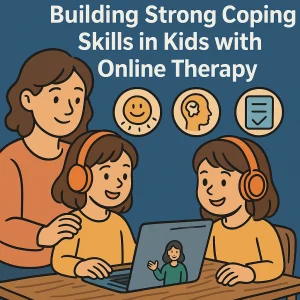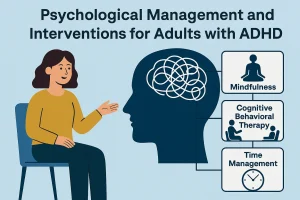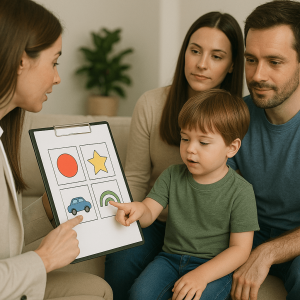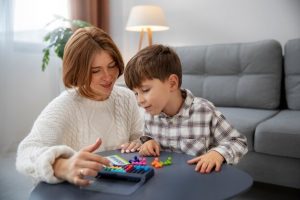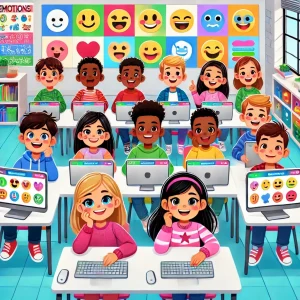Top Tips to Keep Kids Focused During Online Learning
Last Updated: August 7, 2024
In today’s world, where online learning is a common part of children’s education, keeping kids focused during virtual classes is a tough task for both parents and teachers. The distractions at home, like toys, TV, and the general restlessness from sitting in front of a screen, can easily pull a child’s attention away from learning. These distractions can lead to missed lessons and lost opportunities for skill development. Finding ways to boost concentration during online classes is essential for making the most of this new way of learning.
Create a Dedicated Learning Space
Creating a dedicated learning space is crucial for enhancing focus in online learning for kids. Unlike traditional classrooms, where the environment is specifically designed for education, the home setting can be filled with distractions that hinder a child’s ability to concentrate. A well-organized and comfortable learning area can help signal to your child that it’s time to focus on schoolwork, creating a mental separation between playtime and study time.
Also Read: Learning Techniques for Students
Tips for Setting Up an Effective Learning Space:
- Choose a Quiet, Clutter-Free Area: Select a spot in your home that is quiet and free from distractions. This could be a corner in the living room, a spare room, or even a section of the kitchen table. The key is to find a place where your child can work without interruptions. Minimizing noise and visual clutter will help your child concentrate better during online classes.
- Ensure the Space Is Comfortable Yet Promotes Focus: Comfort is important, but the space should also encourage attentiveness. A good chair and desk setup that suits your child’s height can prevent discomfort and distractions. Ensure proper lighting, either natural or from a lamp, to reduce eye strain. However, avoid making the space too cozy, as this might lead to drowsiness or a lack of focus.
- Keep Learning Materials Organized and Accessible: Organization is key to maintaining a productive learning environment. Use shelves, bins, or drawers to keep books, notebooks, and other supplies neatly arranged. This not only helps in reducing clutter but also makes it easy for your child to find what they need quickly, avoiding unnecessary interruptions. Encourage your child to maintain this organization by putting things back in their designated places after use.
Optimize Lesson Duration
One of the key factors in improving concentration in kids during online classes is optimizing lesson duration. Finding the right balance between lesson length and content delivery can significantly impact a child’s ability to stay focused and retain information. If lessons are too long, children may become restless and lose interest; if they are too short, there might not be enough time to cover important material thoroughly.
Importance of Appropriate Lesson Lengths
Children’s attention spans vary by age, and it’s important to tailor lesson durations to match these differences. Younger children generally have shorter attention spans, making it crucial to keep lessons concise and engaging. For older students, longer sessions can be more appropriate, provided they are interactive and break up the monotony.
Ideal Session Durations Based on Age Groups
- Young Children (Ages 4-7): For this age group, lessons should ideally last around 20-30 minutes. This duration is short enough to keep them engaged without overwhelming them. Incorporating short, interactive activities within the lesson can also help maintain their attention.
- Elementary School Students (Ages 8-12): Children in this age group can handle slightly longer sessions, ranging from 30-45 minutes. It’s beneficial to include a mix of instructional content and interactive elements, such as quizzes or discussions, to keep them involved.
- Middle and High School Students (Ages 13 and Up): Older students can manage lessons that last between 45 minutes to an hour. These sessions can delve deeper into complex topics, but it’s still important to provide breaks and interactive activities to prevent fatigue and maintain concentration.
Benefits of Finding the Right Balance
Striking the right balance between lesson length and content delivery has several benefits. It helps prevent cognitive overload, keeps children engaged, and enhances their ability to absorb and retain information. By tailoring lesson durations to match the developmental stages of students, educators can create a more effective and enjoyable learning experience.
Additionally, shorter and well-paced lessons can reduce stress and burnout for both students and teachers. This approach allows for more flexibility in scheduling, enabling students to take necessary breaks and recharge, ultimately leading to better academic performance and well-being.
Utilize Smaller Class Sizes
Smaller class sizes play a crucial role in enhancing focus techniques for children in virtual learning environments. One of the most significant advantages of smaller classes is the ability to provide personalized attention to each student. When teachers can interact more closely with a smaller group of students, they can better understand each child’s unique learning style, strengths, and areas for improvement. This tailored approach not only fosters a more supportive learning atmosphere but also helps children stay more engaged and focused during lessons.
Advantages of Smaller Class Sizes
- Personalized Attention: In a smaller class, teachers can offer individualized support and feedback. This direct interaction helps address specific questions and concerns, making students feel more involved and valued. It also allows teachers to adjust their teaching methods to suit the needs of each child, enhancing their learning experience.
- Increased Engagement and Focus: Smaller classes enable more active participation. Students are more likely to engage in discussions, ask questions, and contribute to class activities when they feel noticed and heard. This increased engagement naturally leads to better focus, as students are more invested in the material being covered.
- Flexibility in Teaching Methods: With fewer students, teachers can experiment with different instructional techniques, such as interactive activities, group projects, or hands-on demonstrations. This variety keeps the learning process dynamic and interesting, preventing monotony and helping maintain students’ attention.
Examples of Effective Smaller Class Formats
- 1-to-1 Sessions: One-on-one lessons are highly effective for personalized learning. They allow the teacher to dedicate their full attention to a single student, providing customized instruction and immediate feedback. This format is particularly beneficial for subjects that require intensive practice or complex understanding.
- Small Group Sessions: Classes with 3-5 students strike a balance between individual attention and collaborative learning. In this setup, students can interact with their peers, share ideas, and learn from each other, all while still receiving ample support from the teacher. This collaborative aspect can enhance critical thinking and problem-solving skills.
Incorporate Multimedia Tools
Incorporating multimedia tools is a powerful strategy to enhance engagement and focus in kids during online learning sessions. The dynamic nature of multimedia—such as videos, animations, and interactive tools—helps break the monotony of traditional teaching methods and caters to various learning styles. This approach not only makes learning more enjoyable but also aids in better comprehension and retention of information.
The Role of Multimedia in Enhancing Learning Engagement
Multimedia elements can transform a standard lesson into an immersive experience. By using visuals, sounds, and interactivity, educators can create a more engaging learning environment that captures and maintains students’ attention. For example, a science lesson can be brought to life with animated diagrams, making complex concepts easier to understand. Similarly, historical events can be explored through interactive timelines or videos, making the subject matter more relatable and memorable.
Suggestions for Using Videos, Animations, and Interactive Tools
- Videos: Educational videos can be a great way to introduce new topics or reinforce learned concepts. They can include documentaries, tutorials, or animated explainers that simplify complex ideas. Platforms like YouTube and educational websites offer a vast array of videos suitable for various subjects and age groups.
- Animations: Animated graphics can illustrate processes and concepts that are difficult to convey through text alone. For instance, animations can show the step-by-step process of photosynthesis or the movement of tectonic plates. These visual aids can make abstract ideas more concrete and understandable.
- Interactive Tools: Tools like virtual whiteboards, quizzes, and interactive games can make learning more interactive. These tools encourage active participation, allowing students to apply what they’ve learned in real-time. For example, virtual labs can enable students to conduct experiments online, while quizzes can provide instant feedback on their understanding of the material.
Benefits of Catering to Different Learning Styles
Every child has a unique way of learning, and multimedia tools can cater to these diverse styles:
- Visual Learners: These students benefit from seeing information. They find charts, diagrams, and videos particularly helpful.
- Auditory Learners: These learners grasp concepts better through listening. Narrated videos, podcasts, and discussions are excellent resources for them.
- Kinesthetic Learners: These students learn best through hands-on activities. Interactive tools like simulations and educational games can help them engage physically and mentally.
Read more: Tips to Develop Good Learning Habits
Allow for Fidgeting and Breaks
In online learning, it’s important to understand that controlled fidgeting and regular breaks can significantly help increase kids’ attention spans. Unlike traditional classrooms, where movement is often discouraged, allowing children to fidget and take breaks can actually improve their ability to focus and learn.
Controlled Fidgeting for Better Focus
Fidgeting can be a natural way for kids to concentrate. When done correctly, it can help them manage their energy and stay attentive. Controlled fidgeting gives children a way to move without distracting themselves or others. For instance, simple actions like tapping their feet or squeezing a stress ball can help some children focus better on their work.
Ideas for Fidget Tools
To encourage controlled fidgeting, consider giving children simple tools they can use quietly during online classes. Some good options include:
- Stress Balls: Quietly squeezing these can provide a calming tactile experience.
- Fidget Spinners: These should be used discreetly to avoid being a distraction.
- Fidget Cubes: These small gadgets offer different tactile options like clicking, flipping, and spinning.
- Rubber Bands or Putty: Stretching and molding these can be soothing and help kids concentrate.
Importance of Regular Breaks and Brain Breaks
Along with controlled fidgeting, regular breaks are crucial for maintaining focus during online learning. Sitting and concentrating for long periods can cause mental fatigue, making it difficult for children to stay engaged. Introducing short, structured breaks, known as “brain breaks,” can refresh the mind and body, helping kids return to their studies with renewed focus.
Benefits of Brain Breaks
- Physical Movement: Encourage activities like stretching, jumping jacks, or a quick walk. Physical activity helps release pent-up energy and improves blood flow, which can enhance concentration.
- Mental Relaxation: A brief break from screens, like drawing or reading a favorite book, can provide a mental reset.
- Mindfulness Exercises: Simple breathing exercises or short mindfulness activities can help children relax and clear their minds.
Fidget Tools and Their Benefits
| Fidget Tool | Description | Benefit |
|---|---|---|
| Stress Balls | Soft, squeezable balls that can be easily held in one hand. | Helps relieve stress and provides a tactile focus point. |
| Fidget Spinners | Small, spinning devices with a bearing in the center that allows them to spin. | Offers a quiet and discreet way to keep hands busy, aiding concentration. |
| Fidget Cubes | Small cubes with different tactile elements on each side, like buttons, dials, and switches. | Provides multiple tactile options, allowing children to explore different textures and actions. |
| Putty/Rubber Bands | Soft, malleable putty or stretchy bands that can be pulled, twisted, and molded. | Encourages tactile interaction and helps with fine motor skills. Provides a soothing outlet for energy. |
Implement New Teaching Methods
Boosting Kids’ Engagement in Online Classes
To keep kids engaged in online classes, it’s important to use innovative and interactive teaching methods. Traditional lectures can often be boring, especially online. By using new strategies, educators can create a more exciting and engaging learning experience that keeps students interested and involved.
Innovative and Interactive Teaching Techniques
Gamified Learning
Gamification means adding game-like elements to lessons. This could involve earning points, badges, or rewards for completing tasks, participating in quizzes, or reaching certain goals. Gamified learning makes education more fun and encourages students to take part actively. For example, a math class could become a game where students earn points for solving problems correctly.
Project-Based Activities
Project-based learning (PBL) lets students work on real-world problems and challenges. This method requires them to use critical thinking, creativity, and teamwork. For instance, students could collaborate to create a digital presentation on a historical event or develop a science experiment. PBL helps students see how what they learn in class applies to real life.
Interactive Simulations and Virtual Labs
Using simulations and virtual labs gives students hands-on experience in subjects like science and technology. These tools let students experiment in a safe, virtual setting, making it easier to understand complex ideas. For example, a virtual lab could allow students to conduct chemistry experiments without needing physical materials.
Know more: How to make your Children Ready for Online Classes? | Online studies
Keeping Content Relevant and Updated
To keep students engaged, it’s important to keep the content fresh and up-to-date. The digital world changes quickly, and so should educational content. This means including current events, the latest research, and new technologies in the lessons. For example, a lesson on environmental science could include recent news about climate change, or a technology class could explore the latest developments in artificial intelligence.
Innovative Teaching Methods and Examples
| Method | Description | Example |
|---|---|---|
| Gamified Learning | Incorporating game-like elements into lessons to make learning more engaging and motivating. | Students earn points and badges for completing tasks and quizzes. |
| Project-Based Learning | Learning through completing projects that involve research, collaboration, and practical application. | Students work in groups to research a topic and present their findings, such as a digital presentation on a historical event. |
| Interactive Simulations | Using virtual environments or tools to simulate real-world scenarios for hands-on learning experiences. | Students participate in virtual science experiments, like simulating chemical reactions or exploring ecosystems. |
Ensure Healthy Lifestyle Choices
Maintaining a healthy lifestyle is crucial for helping children stay focused in virtual education. Diet, hydration, physical activity, and adequate sleep all play significant roles in a child’s ability to concentrate and perform well academically. By promoting healthy habits, parents and educators can support children’s overall well-being and enhance their focus during online learning sessions.
Impact of Diet and Hydration on Focus
The food children eat and the amount of water they drink can significantly affect their cognitive function and concentration levels. A balanced diet rich in essential nutrients provides the energy and nourishment needed for optimal brain function. On the other hand, poor dietary choices, such as high-sugar snacks and processed foods, can lead to energy crashes and difficulty focusing.
Recommendations for Brain-Boosting Foods and Regular Water Intake
- Brain-Boosting Foods:
- Whole Grains: Foods like oatmeal, whole grain bread, and brown rice provide a steady supply of glucose, which is essential for maintaining energy levels and concentration.
- Fruits and Vegetables: These are rich in vitamins, minerals, and antioxidants that support brain health. Berries, oranges, spinach, and broccoli are excellent choices.
- Healthy Fats: Foods like avocados, nuts, seeds, and fatty fish (such as salmon) are high in omega-3 fatty acids, which are crucial for brain function.
- Protein: Eggs, lean meats, beans, and legumes provide essential amino acids that help with neurotransmitter production, improving focus and mood.
- Regular Water Intake: Staying hydrated is equally important for maintaining focus and cognitive function. Dehydration can lead to headaches, fatigue, and reduced concentration. Encourage children to drink water regularly throughout the day. A good rule of thumb is to have a glass of water with each meal and snack, and more during physical activities.
Learn more: Food affecting your stress in all the ways | know more how food affects your mood
Importance of Physical Activity and Adequate Sleep
- Physical Activity: Regular physical activity helps improve blood flow to the brain, enhancing cognitive function and concentration. It also helps reduce stress and anxiety, which can negatively impact focus. Encourage children to engage in at least 60 minutes of moderate to vigorous physical activity daily. This can include activities like playing sports, dancing, cycling, or simply playing outside.
- Adequate Sleep: Sleep is essential for brain health and overall well-being. Lack of sleep can lead to irritability, difficulty concentrating, and decreased academic performance. Ensure that children get the recommended amount of sleep for their age group—typically, 9-11 hours per night for school-aged children. Establish a consistent bedtime routine and create a calming environment to help them wind down.
Address Attention Issues Proactively
Maintaining focus during virtual learning can be particularly challenging for children who experience attention issues, such as ADHD (Attention-Deficit/Hyperactivity Disorder). Recognizing and addressing these challenges proactively is essential for creating a supportive and effective learning environment at home.
Signs of Attention Issues Like ADHD
Children with attention issues may exhibit various signs that indicate difficulty in maintaining focus. Some common symptoms of ADHD include:
- Inattention: Difficulty sustaining attention in tasks or play activities, making careless mistakes, not listening when spoken to directly, and being easily distracted.
- Hyperactivity: Fidgeting, squirming in seats, running or climbing in inappropriate situations, and having trouble playing quietly.
- Impulsivity: Interrupting others, difficulty waiting for their turn, and blurting out answers before questions are completed.
Also read: How Behavioral Therapy Helps Kids with ADHD
Encouraging Professional Help
If you suspect your child may have attention issues like ADHD, seeking professional help is a crucial step. Consulting with a healthcare provider, such as a pediatrician or child psychologist, can lead to a proper diagnosis and appropriate interventions. Professionals can offer various treatment options, including behavioral therapies, medication, or a combination of both. Early intervention can make a significant difference in managing symptoms and improving a child’s learning experience.
Tips for Creating a Supportive Learning Environment at Home
- Structured Routine: Establish a consistent daily schedule that includes time for learning, breaks, physical activity, and relaxation. A predictable routine can help children with attention issues feel more secure and focused.
- Minimize Distractions: Create a quiet, organized, and clutter-free learning space. Limit potential distractions, such as toys, electronics, or background noise, to help your child concentrate on their lessons.
- Break Tasks into Manageable Chunks: Long assignments can be overwhelming for children with attention issues. Break tasks into smaller, more manageable segments with clear instructions. Providing short, frequent breaks can also help maintain focus.
- Use Positive Reinforcement: Praise and reward positive behavior and effort. Encouragement and positive reinforcement can motivate children to stay on task and complete their work.
- Incorporate Movement and Breaks: Allow for short breaks that include physical movement, such as stretching or a quick walk. Physical activity can help release built-up energy and improve concentration.
- Set Clear Expectations and Goals: Clearly communicate what is expected during learning sessions. Setting achievable goals and providing feedback can help children stay focused and motivated.
Conclusion
In this article, we’ve explored various strategies to enhance focus during online learning sessions for kids. From creating a dedicated learning space and optimizing lesson durations to incorporating multimedia tools and allowing for fidgeting and breaks, each approach offers unique benefits for maintaining engagement and concentration. We’ve also discussed the importance of implementing new teaching methods, ensuring healthy lifestyle choices, and addressing attention issues proactively.
A holistic approach is essential for helping children stay focused and succeed in virtual education. It’s not just about academic content; it’s also about creating a supportive environment that nurtures both the mind and body. This includes fostering healthy habits, utilizing innovative teaching techniques, and providing the right tools and resources.
Frequently Asked Questions:
1. How can I create a dedicated learning space for my child at home?
To create a dedicated learning space, choose a quiet and clutter-free area with good lighting. Ensure the space is comfortable, with a proper desk and chair, and keep learning materials organized and easily accessible.
2. What is the ideal duration for online classes for different age groups?
For young children (ages 4-7), online lessons should last about 20-30 minutes. Elementary students (ages 8-12) can handle 30-45 minute sessions, while older students (ages 13 and up) may benefit from 45-minute to 1-hour classes.
3. How do smaller class sizes help improve focus in online learning?
Smaller class sizes allow for personalized attention and active participation. This setup enables teachers to cater to individual learning styles and keep students engaged, leading to better focus and understanding.
4. What are some effective multimedia tools for online learning?
Effective multimedia tools include educational videos, animations, and interactive tools like virtual whiteboards and quizzes. These tools cater to various learning styles, making lessons more engaging and easier to understand.
5. Why are breaks important during online learning?
Regular breaks help prevent mental fatigue and maintain focus. Short physical activities or simple mindfulness exercises during breaks can refresh the mind, allowing children to return to their lessons with renewed energy.
6. What healthy foods can improve my child’s focus during online classes?
Foods rich in whole grains, fruits, vegetables, healthy fats, and proteins are great for boosting brain function. Encourage your child to stay hydrated by drinking plenty of water throughout the day.
7. How can I help my child who struggles with attention issues like ADHD?
Recognize the signs of attention issues and seek professional help if needed. Create a structured routine, minimize distractions, and use positive reinforcement to support your child’s focus during online learning.
8. What are some innovative teaching methods for online learning?
Innovative methods include gamified learning, project-based activities, and interactive simulations. These approaches make learning more engaging and relevant, helping to keep students interested and motivated.
9. How does a healthy lifestyle contribute to better focus in virtual education?
A healthy lifestyle, including a balanced diet, regular physical activity, and adequate sleep, supports cognitive function and overall well-being. These factors are crucial for maintaining focus and academic performance.
10. What resources does Wellness Hub offer to support children’s online learning?
Wellness Hub provides a variety of resources, including educational therapy services and professional counseling. Our programs are designed to support children’s academic and emotional well-being, helping them succeed in their online learning journey.
About Author:
Lasya Vooturi
Clinical Psychologist and Behavioral Therapist
Lasya holds a Professional Diploma in Clinical Psychology from Amity University, where she deepened her understanding of psychological principles from March 2023 to March 2024. With over a year of dedicated experience as a Behavioral Therapist, Lasya has honed her skills in applying effective therapy techniques tailored to individual needs. Fluent in Telugu, Hindi, and English, she is adept at connecting with a diverse range of clients, ensuring comprehensive communication and understanding. Lasya’s approach is grounded in empathy and scientific rigor, making her a trusted ally in navigating mental health challenges.
Book your Free Consultation Today
Parent/Caregiver Info:
Client’s Details:
* Error Message
